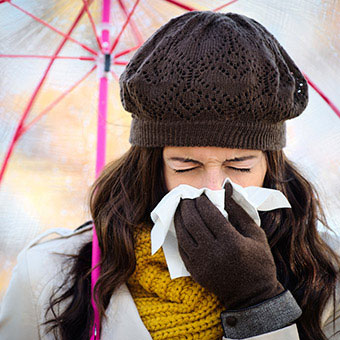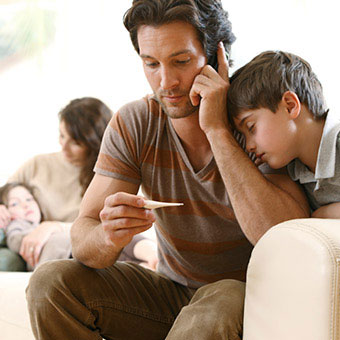Common Cold
- Facts
- Causes
- Contagious
- Symptoms/Signs
- Stages
- Cold vs. Flu
- Doctor and Specialists
- Diagnosis
- Treatment
- Antibiotics
- How Long Does It Last
- Prevention

Common cold facts
- The common cold is an upper respiratory tract infection caused by many different viruses.
- The common cold is transmitted by virus-infected airborne droplets or by direct contact with infected secretions.
- Typical common cold symptoms include
- cough,
- sore throat,
- coughing,
- sneezing, and
- a runny nose.
- Being in cold weather does not cause the common cold, but cold weather promotes close contact.
- Over-the-counter medications may be used for the treatment of the common cold.
- Antibiotics are not necessary for the common cold.
- The common cold is a self-limited disease that can generally be managed at home.
- Most people with a common cold recovered in about 7 to 10 days.
- The common cold has no cure, and there is no available vaccine.

What is the common cold? What causes the common cold?
The common cold is a self-limited contagious disease that can be caused by a number of different types of viruses. The common cold is medically referred to as a viral upper respiratory tract infection. Symptoms of the common cold may include cough, sore throat, low-grade fever, nasal congestion, runny nose, and sneezing. More than 200 different types of viruses are known to cause the common cold, with rhinovirus causing approximately 30%-40% of all adult colds.
- Rhinovirus multiplies best at temperatures found in the nose.
- Rhinovirus infection rates peak from September to November and March to May.
- Nevertheless, rhinovirus may cause disease at any time of year. During peak periods, up to 80% of colds may be due to rhinovirus.
Other commonly implicated viruses include coronavirus (COVID-19), adenovirus, respiratory syncytial virus, and parainfluenza virus. Because so many different viruses can cause the common cold, and because new cold viruses constantly develop, the body never builds up resistance against all of them. For this reason, colds are a frequent and recurring problem. In fact, children in preschool and elementary school can have six to 12 colds per year while adolescents and adults typically have two to four colds per year.
- The common cold occurs most frequently during the fall, winter, and spring.
- The common cold is the most frequently occurring viral infection in the world, and it is a leading cause of doctor visits and missed days from school and work.
- It is estimated that individuals in the United States suffer an estimated 1 billion colds per year, with approximately 22 million days of school absences recorded annually.
- In the United States, the common cold is thought to account for approximately 75-100 million physician visits annually, with an economic impact of greater than $20 billion per year due to cold-related work loss.

How does the common cold spread?
The common cold is spread either by direct contact with infected secretions from contaminated surfaces or by inhaling the airborne virus after individuals sneeze or cough. Person-to-person transmission often occurs when an individual has a cold blow or touches their nose and then touches someone or something else. A healthy individual who then makes direct contact with these secretions can subsequently become infected, often after their contaminated hands contact their own eyes, nose, or mouth. A cold virus can live on frequently touched objects such as doorknobs, pens, books, cell phones, computer keyboards, and coffee cups for several hours and can thus be acquired from contact with these objects.
How long is the common cold contagious?
In general, the common cold can be contagious anywhere from one to two days before the symptoms begin up until the symptoms have completely resolved. However, the common cold is typically most contagious during the initial two to three days of illness.

What are risk factors for acquiring the common cold?
There are various risk factors that may increase the chances of acquiring the common cold, including the following:
- Age: Infants and young children are more likely to develop the common cold because they have not yet developed immunity to many of the implicated viruses.
- Seasonal variation: Individuals more commonly acquire the common cold during the fall, winter, or rainy season (in warmer climates). This is felt to occur because people tend to stay indoors and are in closer proximity to one another.
- Weakened immune system: Individuals with a poorly functioning immune system are more likely to develop the common cold. Also, individuals with excessive fatigue or emotional distress may be more susceptible to catching a common cold.

What are the symptoms and incubation period of the common cold?
Common cold symptoms typically begin two to three days after acquiring the infection (incubation period), though this may vary depending on the type of virus causing the infection. Individuals also tend to be most contagious during the initial two to three days of having symptoms. Cold viruses target mainly the upper respiratory tract (nose, sinuses, and throat). Symptoms and signs of the common cold may also vary depending on the virus responsible for the infection and may include
- stuffy nose or nasal drainage,
- sore or scratchy throat,
- sneezing,
- hoarseness,
- cough,
- low-grade fever,
- headache,
- earache,
- body aches,
- loss of appetite, and
- fatigue.
The signs and symptoms of the common cold in infants and children are similar to those seen in adults. The cold may begin with a runny nose with clear nasal discharge, which later may become yellowish or greenish in color. Infants and children may also become fussy and have decreased appetite.

Does it have anything to do with exposure to cold weather?
Though the common cold usually occurs in the winter months, the cold weather itself does not cause the common cold. Rather, it is thought that during cold-weather months, people spend more time indoors near each other, thus facilitating the spread of the virus. For this same reason, children in day care and school are particularly prone to acquiring the common cold. The low humidity during these colder months is also felt to contribute to the increased prevalence of the common cold, as many of the implicated viruses seem to survive better in low-humidity conditions.
What are the stages of the common cold?
Because the common cold can be caused by so many different viruses, the progression and severity of symptoms vary from individual to individual. In general, symptoms will develop two to three days after the virus is contracted. Some individuals will develop very mild symptoms whereas others will develop more severe symptoms. The type of symptoms will also vary, with some individuals developing only nasal congestion, while others may develop many or all of the symptoms described above. The symptoms that develop also depend on the underlying health of the person infected.
Most colds will resolve after seven to 10 days, though some individuals experience a shorter course and others a more prolonged illness, again depending on the particular virus involved, as well as the infected person's underlying health issues.

Common cold vs. flu (influenza)
Many people confuse the common cold with influenza (the flu).
- Flu is caused by the influenza virus, while the common cold generally is not.
- While some of the symptoms of the common cold and flu may be similar, patients with the common cold typically have a milder illness than patients with the flu.
- Patients with the flu usually appear more ill and have a more abrupt onset of illness with fever, chills, headache, substantial muscle and body aches, dry cough, and extreme weakness.
There is laboratory testing available to confirm the diagnosis of influenza, but health care professionals make a diagnosis of flu primarily based on classic flu symptoms rather than laboratory tests.

What types of doctors treat the common cold?
A general practitioner most often diagnoses and treats the common cold, in addition to family medicine physicians, internists, and pediatricians. If you visit an emergency department, an emergency medicine physician will likely treat you. An infectious disease specialist may consult hospitalized individuals with very weakened immune systems, such as those who have had an organ or bone marrow transplant or have had recent chemotherapy for cancer.
How do health care professionals diagnose the common cold?
A doctor or health care professional will generally diagnose the common cold based on the description of the symptoms and the findings during the physical exam. Laboratory testing and imaging studies are generally not necessary unless there are concerns about another underlying medical condition, such as a bacterial disease or potential complications of the common cold.

What is the treatment for the common cold? Are there any home remedies for the common cold?
There is no cure for the common cold. The common cold is a self-limiting illness that will resolve spontaneously with time and expectant management. Home remedies and medical treatments are directed at alleviating the symptoms associated with the common cold while the body fights off the infection.
Home treatment for upper respiratory infections includes getting rest and drinking plenty of fluids. In older children and adults, common over-the-counter drugs such as throat lozenges, throat sprays, cough drops, and cough syrups may help relieve symptoms, though they will not prevent or shorten the duration of the common cold. Gargling with warm salt water may help people with sore throats. Decongestant drugs such as pseudoephedrine (Sudafed) or antihistamines may be used for nasal symptoms, while saline nasal sprays may also be beneficial. It is important to note that over-the-counter medications may cause undesirable side effects, therefore they must be taken with care and as directed. Pregnant women should discuss the safety of common over-the-counter medications with their pharmacist or health care professional.
Acetaminophen (Tylenol and others) and non-steroidal anti-inflammatory drugs such as ibuprofen (Advil, Motrin) are common over-the-counter medicines that can help with fever, sore throat, headache, and body aches.
The treatment for infants and small children with the common cold is supportive as well. It is especially important to allow rest and encourage plenty of fluids in order to prevent dehydration. Nasal drops and bulb suctioning may be used to clear nasal mucus from the nasal passages in infants. Medicines such as acetaminophen and ibuprofen may be taken for pain or fever based on the package recommendations for age and weight. Do not use aspirin or aspirin-containing medications in children or teenagers because it has been associated with a rare, potentially fatal condition called Reye's syndrome. Finally, over-the-counter cough and cold medications for infants and young children are not recommended. Medication manufacturers now recommend that over-the-counter cough and cold drugs not be used in children younger than 4 years of age because of serious and potentially life-threatening side effects.
Learn more about: ibuprofen
Common alternative treatments to prevent or treat the common cold, such as vitamin C, zinc, echinacea, and other herbal remedies, have had mixed results in studies evaluating their effectiveness. Therefore, discuss these treatment options with a health care professional.

Are antibiotics a suitable treatment for the common cold?
No. Antibiotics play no role in treating the common cold. Antibiotics are effective only against illnesses caused by bacteria, and colds are caused by viruses. Not only do antibiotics not help, but they can rarely also cause severe allergic reactions that can sometimes be fatal. Furthermore, using antibiotics when they are not necessary has led to the growth of several strains of common bacteria that have become resistant to certain antibiotics. For these and other reasons, it is important to limit the use of antibiotics to situations in which they are medically indicated.
Occasionally, a bacterial infection such as sinusitis or a middle ear infection (acute otitis media) can develop following the common cold, however, the decision to treat with antibiotics should be determined by a doctor or health care professional after a medical evaluation. About 30% of children with middle ear infections have rhinovirus. Because middle ear infection may be viral, some experts suggest treating acute otitis media in children with non-steroidal anti-inflammatory drugs and resorting to antibiotics only if there is worsening or no improvement.
When should someone consult a health care professional?
In general, the common cold can be treated at home and managed with over-the-counter medications. However, if more severe symptoms develop, such as
- shaking chills,
- high fever (greater than 102 F),
- severe headache,
- neck stiffness,
- vomiting,
- abdominal pain,
- difficulty breathing,
- chest pain,
- confusion, or failure to improve after 10 days,
Consult a health care professional immediately, if these severe symptoms occur. Infants 3 months of age or younger who develop a cold or fever should consult a health care professional as well.
If a sore throat and a fever are present with no other cold symptoms, the individual should also be evaluated by a health care professional. This illness may be strep throat, a bacterial infection requiring treatment with antibiotics.
Finally, if there is facial pain, redness, or swelling associated with yellow/green drainage from the nose accompanied by a fever, it is possible that the individual has a bacterial sinus infection (sinusitis) that would benefit from a medical evaluation and a possible course of antibiotics.

What is the prognosis for the common cold? What is the duration of the common cold?
Generally, the prognosis for the common cold is excellent. The common cold needs to run its natural course, and most people with the common cold will recover within seven to 10 days. However, certain viruses may take up to three weeks to completely resolve.
What are complications of the common cold?
Complications that may arise from the common cold include the development of a bacterial middle ear infection (otitis media) or bacterial sinusitis. In individuals with asthma or chronic obstructive pulmonary disease (COPD), the common cold can sometimes trigger an exacerbation of their illness, leading to shortness of breath and increased wheezing. Though uncommon, pneumonia can sometimes develop as a secondary infection in individuals with the common cold. For example, coronaviruses, rhinoviruses, and several other cold-causing viruses can cause bronchitis and pneumonia in people with very weakened immune systems. Get an evaluation by a health care professional for any of these suspected complications.

Is it possible to prevent the common cold?
The most important prevention measure for the common cold is to avoid contact with infected individuals. Other measures for prevention of the common cold include the following:
- Frequent and thorough hand washing during flu and cold season is extremely important, as this can destroy viruses acquired from touching contaminated surfaces. In between using soap and water when hands are visibly dirty, use an alcohol-based hand sanitizer containing at least 60% alcohol.
- Disinfect frequently touched surfaces or personal objects with a product that is effective against flu and cold-causing viruses (and safe for the type of surface).
- Do not share personal belongings such as towels, handkerchiefs, or tissues.
- Avoid sharing utensils and try to use disposable items (such as disposable cups) if someone in the family has a cold.
- Encourage individuals to cover their nose and mouth when coughing or sneezing to prevent transmission of the virus. A sneeze can spray a fine mist of contagious droplets up to 6 feet.
- Lifestyle modifications such as smoking cessation and stress management may decrease susceptibility to acquiring the common cold.
- If the air in the home is very dry during the winter, a cool-mist humidifier or vaporizer may be helpful.
Currently, there is no effective vaccine against the common cold.
Where can people find more information about the common cold?
Centers for Disease Control and Prevention (CDC)
https://www.cdc.gov/features/rhinoviruses/
U.S. Department of Health and Human Services, National Institutes of Health
https://nccih.nih.gov/heatlh/flu/indepth
Email address: [email protected]


